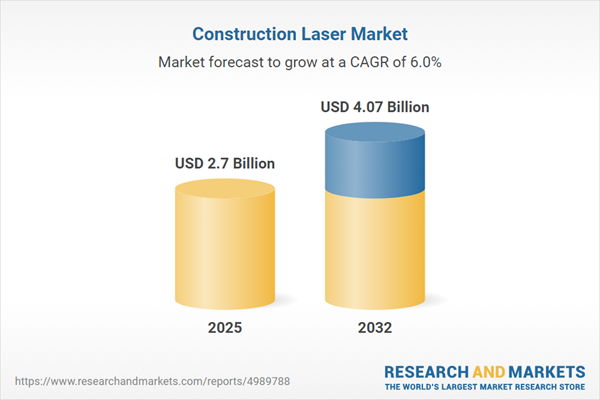Speak directly to the analyst to clarify any post sales queries you may have.
The construction laser market is transforming how global projects achieve accuracy, efficiency, and integration. With advances in digital control and connectivity, today’s construction laser systems play a strategic role across commercial, industrial, and public infrastructure workflows.
Market Snapshot: Growth Trajectory and Opportunities
The construction laser market grew from USD 2.55 billion in 2024 to USD 2.70 billion in 2025. It is expected to continue growing at a CAGR of 6.01%, reaching USD 4.07 billion by 2032. This growth reflects surging demand for technology that enhances measurement precision and aligns with digital construction trends across key global regions.
Scope & Segmentation of the Construction Laser Market
- Laser Types: Combination lasers, line lasers, plumb/dot lasers, point lasers, and rotary lasers supporting diverse functional roles from interior fit-out to large-scale outdoor grading.
- Operational Ranges: Systems designed for below 100 ft, 100 to 200 ft, and above 200 ft, addressing requirements from compact renovation tasks to major infrastructure setups.
- Application Areas: Land surveying, leveling and alignment tasks, plumbing, and integrated plumbing with electrical works utilize these precision instruments for exacting demands.
- End-User Industries: Commercial construction, industrial builds, infrastructure including bridges and roads, and residential construction segments each require features ranging from robustness to user-friendly interfaces.
- Sales Channels: Procured via offline dealer/retail networks or digital e-commerce platforms, supporting a range of procurement models.
- Regional Breakdown: Americas (North and Latin America), Europe, Middle East & Africa, and Asia-Pacific, with tailored market dynamics influenced by regulatory climates, infrastructure investment, and construction cycles.
- Key Technologies: Inclusion of wireless connectivity, sensor miniaturization, self-leveling automation, and integration into digital construction platforms accelerate market adoption.
Key Takeaways for Senior Decision-Makers
- Construction laser systems drive measurable operational efficiency by significantly reducing setup times and error rates, especially within complex job sites.
- Integration with building information modeling and project management platforms allows real-time monitoring and quality assurance, supporting precise project outcomes.
- Product durability, safety enhancements, and electricity-efficient components align with stricter regulatory and sustainability mandates globally.
- Regional market variances influence technology adoption and partnership strategies, requiring tailored go-to-market approaches for mature and emerging economies.
- Collaboration among device manufacturers, software vendors, and standards bodies is creating new cross-platform interoperability standards, supporting unified construction workflows.
Tariff Impact and Supply Chain Shifts
Recent U.S. tariff policies on key components and finished devices have produced cost realignments and heightened the importance of diversified sourcing and local partnerships. Many industry players are recalibrating supplier agreements and considering localized assembly to contain costs and mitigate import risks. Pricing strategies now reflect the need to maintain competitive positioning in both price-sensitive and premium market segments.
Primary Keyword: Construction Laser Market – Methodology & Data Sources
This research leverages a robust multi-stage methodology, incorporating extensive secondary analysis of technical white papers, journals, and regulatory documents, complemented by expert interviews and end-user feedback. Quantitative and qualitative findings were cross-validated with industry benchmarks and internal data for integrity and actionable insight.
Why This Report Matters
- Enables informed decision-making by presenting strategic insights grounded in rigorous analysis and up-to-date industry perspectives.
- Supports targeted business development by highlighting segmentation relevance and technology adoption patterns across diverse regions and sectors.
- Helps organizations proactively adapt to shifting regulatory and supply-chain contexts, positioning them for sustained profitability and resilience.
Conclusion
The construction laser market will continue to evolve through digital integration, regulatory shifts, and the collaborative efforts of leading industry players. Organizations equipped with current market intelligence can drive innovation, optimize operations, and remain agile in a rapidly developing landscape.
Additional Product Information:
- Purchase of this report includes 1 year online access with quarterly updates.
- This report can be updated on request. Please contact our Customer Experience team using the Ask a Question widget on our website.
Table of Contents
3. Executive Summary
4. Market Overview
7. Cumulative Impact of Artificial Intelligence 2025
Companies Mentioned
The companies profiled in this Construction Laser market report include:- Alpine Industries Ltd.
- Bushnell by Vista Outdoor Inc.
- Faro Technologies, Inc.
- Fluke Corporation
- Geo-Fennel GmbH
- GEO-Laser GmbH
- Hexagon AB
- Hilti Corporation
- Johnson Level & Tool Mfg. Co., Inc.
- Kapro Industries Ltd.
- Klein Tools, Inc.
- Laser Technology, Inc.
- Laser Tools Co.
- Makita Corporation
- Milwaukee Electric Tool Corporation
- Nedo GmbH & Co. KG
- Nikon Corporation
- Robert Bosch GmbH
- STABILA Messgeräte Gustav Ullrich GmbH
- Stanley Black & Decker, Inc.
- Theis Feinwerktechnik GmbH
- Topcon Positioning Systems, Inc.
- ToughBuilt Industries Inc.
- Trimble Inc.
Table Information
| Report Attribute | Details |
|---|---|
| No. of Pages | 190 |
| Published | November 2025 |
| Forecast Period | 2025 - 2032 |
| Estimated Market Value ( USD | $ 2.7 Billion |
| Forecasted Market Value ( USD | $ 4.07 Billion |
| Compound Annual Growth Rate | 6.0% |
| Regions Covered | Global |
| No. of Companies Mentioned | 25 |









